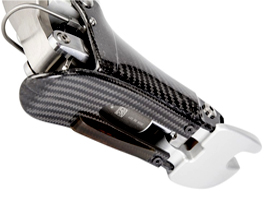A number of different prosthetic feet are available to meet the different needs of individuals with lower limb amputations.

A number of different prosthetic feet are available to meet the different needs of individuals with lower limb amputations. While most prosthetic feet belong to one of the main categories listed below, there are also prosthetic feet that combine features and functionality across multiple foot classes. Your clinician will evaluate your specific needs and activities and help you decide which option is best for you.
Learn more about each type of technology below.
Hydraulic Ankle
Hydraulic ankle legs allow resistive movement of the prosthetic foot in an adjustable hydraulic ankle joint. This allows for a more stable gait, adapts to walking on a wider range of surfaces and environmental obstacles, and may reduce localized socket pressure points for some patients.
Microprocessor Legs
Microprocessors change the resistance of the prosthetic ankle in real time based on your walking speed, incline or incline, and terrain type. Patients also recommend that this developing technology increases socket comfort and reduces stumbling and falling.
Electric Feet
Electric feet use battery power to mimic the powerful thrust of the foot and ankle muscles. These feet are usually relatively heavy and require daily battery recharges. However, eligible patients have reported reduced fatigue with the use of this technology.
Dynamic Response Feet
Dynamic reaction feet store energy through each step through the deformation of their carbon structures. These structures return to their original shape at the end of each step, resulting in a return of stored energy and a more natural, fluid gait.
axial foot
Uniaxial feet mimic the movement of the ankle joint by allowing movement in a mechanical ankle joint. They provide stability, are often recommended for more reserved walkers, and can be especially valuable for patients with poor knee control or those who are limited to walking with an above-knee prosthesis. Multi-axis feet allow for damped movements of the foot in several planes, which helps improve stability and comfort on uneven surfaces.
Sturdy Ankle Cushion Heel (SACH)
SACH feet are a lightweight, basic prosthetic option that is ideal for light activity.
Partial Feet and Toes
Partial toe and toe solutions can improve balance, help fit shoes, and provide cosmetic restoration.